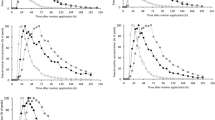Abstract
The measurement of passage rate is important for the concept of ruminant diversification. While supporters of Hofmann's 1989 feeding type classification claim that browsing ruminants have faster passage rates than grazing ruminants, other researchers consider the passage rate to depend on body size alone. To date, no convincing comparison of ruminant passage rates has been put forward. For comparative purposes, we suggest the use of the "selectivity factor", which is an expression of how much longer particles of a defined size (<2 mm) are retained in the ruminant digestive tract than fluids. From the limited data available, it seems that grazing ruminants display selectivity factors between 1.56 and 3.80, whereas browsers have a much narrower range of 1.14–1.80. This suggests that browsers are not able to selectively retain particles as long as grazers. Intake of browsers, on the other hand, may not be limited by physical fill of the forestomach to the same degree as in grazers. This result can explain several observations on the digestive physiology of browsers, some of which have been linked to a rumen bypass mechanism. We propose that the ability for selective particle retention is a key factor for understanding the physiological consequences of ruminant diversification.
Similar content being viewed by others
Author information
Authors and Affiliations
Additional information
Electronic Publication
Rights and permissions
About this article
Cite this article
Clauss, M., Lechner-Doll, M. Differences in selective reticulo-ruminal particle retention as a key factor in ruminant diversification. Oecologia 129, 321–327 (2001). https://doi.org/10.1007/s004420100735
Received:
Accepted:
Published:
Issue Date:
DOI: https://doi.org/10.1007/s004420100735




